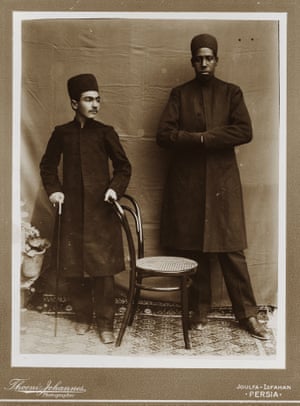The Origins of Slavery
"West Africa had long been targeted by Muslim slavers from the north and east. Now their European counterparts began to make their presence felt. As the slave trade settled into its grisly triangle of suffering between Europe, Africa and America, large stone fortresses mushroomed on the West African coast, complete with dungeons and manned by whoever was willing. Massive barracoons were built to hold the human cargo; and they were built to last -- they were still in use, as dwellings, in the 1950s."*Captain James Kingston Tuckey ... entered the River Congo in 1816 on an exploratory, semi-scientific mission with the 100-ton British Admiralty ship Congo and its 56 crew.
"Initially it was like a nursery vision of Africa -- crystal-clear water above a smooth, red clay bed; smoke rising from happy villages; parrots flying in streams at dawn and dusk across the mangrove swamps to feed off the cornfields on the opposite bank; comfortable temperatures which never rose above 76-F; and, to provide the necessary touch of mystery, a huge, natural pillar of stone near the river's mouth surrounded by whirlpools and carved with innumerable symbols, which was a fetish of Seembi, the river's protective deity. As they sailed upriver, however, the reality became apparent. Down-at-heel despots wearing cheap tiaras, cast-off uniforms, beadle's cloaks, and displaying horrible skin conditions, came aboard to demand gifts and rum -- one man stayed five days to make sure the cask was empty. Poverty was endemic, as was warfare. Poisoning was so commonplace that every man of importance employed a food-taster -- not that there was much food to be tasted in most places. Once having purchased a sheep and skinned it for dinner, Tuckey was horrified to find a man chewing its hide, wool and all, that had been roasted to lukewarm on a fire. Even where the land was capable of producing food, agriculture was pursued in a half-hearted, apathetic fashion, cattle being left to roam indiscriminately, never milked and often slaughtered in calf."*
"The cause of this economic ruin was slavery, which had been practised so relentlessly over the last 300 years that it was now a fact of life. Few people dared venture a day's walk from their village lest they be kidnapped by marauding gangs. Being sold as a slave had even entered the penal code as punishment for adultery with a chief's wife. Warfare was conducted for no other purpose than the capture of slaves. Human beings had become the region's major product, the sole currency with which chieftains could buy the shoddy wonders of European civilization. The price of a man was fixed with all the exactitude of foreign exchange. The rate, in Tuckey's time, was two muskets, two casks of gunpowder, fifty-two yards of cloth, one fancy sash, two jars of brandy, five knives, five strings of beads, one razor, one looking-glass, one cap, one iron bar, one pair of 'scizzars' and a padlock. Now and then Tuckey caught glimpses of the trade. Hard-bitten slavers carrying British and
American crews and sailing under Spanish or Portuguese colours flitted by night past the Congo, sending an occasional cannon-ball its way, as they went about the business of lifting what Tuckey estimated to be 2,000 slaves per year from the Congo River -- a relatively modest haul compared to other areas."*
From: Barrow's Boys by Fergus Fleming, Atlantic Monthly Press, 1998
| Around 1600 AD, European pirates brought advanced sailing
and shipbuilding techniques to the Barbary Coast, which enabled the
corsairs to extend their activities into the Atlantic Ocean, and the
impact of Barbary raids peaked in the early to mid-17th century. While the Barbary slave trade is typically portrayed as Muslim corsairs capturing white Christian victims, this is far too simplistic. In reality, the corsairs were not concerned with the race or religious orientation of those they captured. Slaves in Barbary could be black, brown or white, Catholic, Protestant, Orthodox, Jewish or Muslim. And the corsairs were not only Muslim; English privateers and Dutch captains also exploited the changing loyalties of an era in which friends could become enemies and enemies friends with the stroke of a pen. "One of the things that both the public and many scholars have tended to take as given is that slavery was always racial in nature,” said historian Robert Davis, author of Christian Slaves, Muslim Masters: White Slavery in the Mediterranean, the Barbary Coast, and Italy . “But that is not true," |
*Slave trading was banned first by Denmark in 1802, by Britain and America in 1808, by Sweden in 1813, by the Netherlands a year later, by France in 1818 and by Spain in 1820 followed by Portugal in 1836 But under-the-counter trading to the Americas went on well into the 1850s.
 Gholam Hoseyn Mirza Masoud, one of Zell-e-Soltan’s sons, with his
personal African slave, Julfa, Isfahan, 1880s Photograph: Thooni
Johannes/Institute for Iranian Contemporary Historical Studies, Tehran,
Iran
Gholam Hoseyn Mirza Masoud, one of Zell-e-Soltan’s sons, with his
personal African slave, Julfa, Isfahan, 1880s Photograph: Thooni
Johannes/Institute for Iranian Contemporary Historical Studies, Tehran,
Iran
Labels: America, Europe, Human Relations, Human Rights, Islam, Slavery
0 Comments:
Post a Comment
<< Home